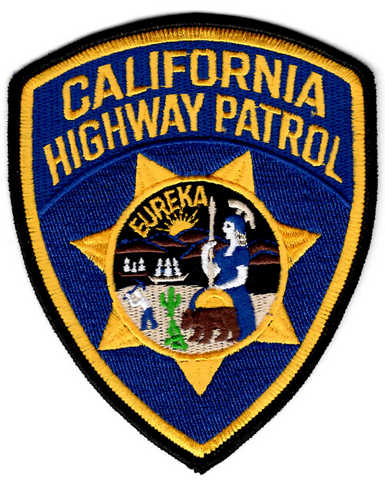California State Police patch Motto Dedicated to Service Agency overview Formed 1887 Dissolved 1995 Superseding agency Employees 271 remained by 1995 (Prior to the CSP-CHP merger hundreds of CSP officers left the department to work for other Law Enforcement Agencies) Legal personality Governmental: Jurisdictional structure Operations jurisdiction of, Map of California State Police's jurisdiction. Governing body General nature. Specialist jurisdiction Buildings and lands occupied or explicitly controlled by the institution and the institution's personnel, and public entering the buildings and precincts of the institution. Operational structure Headquarters, Footnotes. Division of the country, over which the agency has usual operational jurisdiction.
Shoulder Patch. The official California Highway Patrol uniform patch was first adopted in 1948. Its birth resulted from legislation which separated the California Highway Patrol from the Department of Motor Vehicles and elevated the patrol to full Department stature. The patch is thought to have been designed by a then active State Traffic Officer.
The California State Police was a agency founded in 1887 which served to protect the, the, other state agencies located throughout the state and thousands of State employees 24 hours a day. They provided services to all state agencies that did not have their own police force. They patrolled the State Water Project (also known as the ) and were the state's de facto. They provided dignitary protection for the and other state officials as directed, including the in. They provided investigative services to elected officials through their Threat Assessment Detail and criminal investigations of crimes committed against the State through the Bureau of Investigative Services. They also performed tax seizures for the and.
Detectives and Line officers routinely conducted investigations with other State Agencies and allied law enforcement departments. State Police officers held jurisdiction throughout the State, providing law enforcement on and off California properties.
The California State Police merged with the in 1995. Contents. Etymology Unlike 48 other states, the title used by the California State Police was always 'Police Officer' unlike the CHP who used 'Traffic Officer' and never 'trooper'. The official shoulder patch was: a green shield w/ gold borders, the words (gold lettering) 'CALIFORNIA STATE POLICE' on top, the State Capitol building's dome and the state flag prominently featured against a 7-point star badge. At the bottom of the patch was a ribbon panel that had gold lettering with the words 'Dedicated to Service.'
Patrol Patches Scout Shop
History The agency traces to 1854 when the state legislature authorized a law enforcement body called the. The Rangers' mission was to capture the notorious gang leader. Joaquin Murrieta was captured, shot, killed and beheaded by Capt. Harry Love at the Arroyo Cantua.
The California State Rangers were then disbanded years later. On March 15, 1887, the authorized a law enforcement body with Captain Harry Love and one other ranger, as its sole members to protect the State Capitol and grounds. They were paid $100.00 monthly and grew to a force of 12 officers. In 1911 the legislature approved more positions, uniforms, and defined the department giving it the official name of, 'California State '. Eventually as the department grew to approximately 400 personnel and its duties expanded, the word 'Capitol' was dropped from the agency's name. Public awareness. This section's tone or style may not reflect the used on Wikipedia.

See Wikipedia's for suggestions. (July 2016) The California State Police (CSP) Division, its official title being a division of the California Department of General Services, was a small agency and its officers and patrol cars were infrequent sights outside of the state’s larger metropolitan areas. Its largest presence was in the (State Capitol Division), and.

Its aircraft could be seen flying along the California Aqueduct. Some of the most visible personnel of the CSP were its State Security Officers (SSOs) who were peace officers while on duty. SSOs held powers of arrest as regular Police Officers under the California Penal Code (CPC), however, they were not full-time peace officers.
Their powers of arrest were only while on duty performing their specific assignments. SSOs were usually at fixed locations at state buildings on foot beats.
SSOs sometimes performed patrol (automobile) duties in very limited geographical areas such as in. Despite the California State Police presence in large metropolitan cities, at the State Capitol, at busy State office buildings, on foot beats, on patrol in fully marked police vehicles on the streets and highways, there were many Californians who were still unaware that California had its own State Police.
Chp Shoulder Patch
This public knowledge of the California State Police didn't fully come to light until its merger with the California Highway Patrol when it received major state news coverage in 1995. At the time of the merger the California State Police was the state’s oldest law enforcement agency (1887-1995 (108 years)), a record that is still held today. The California Highway Patrol (CHP) was founded in 1929 and its officers were classified as 'State Traffic Officers' until the merger. After the merger and subsequent charter responsibilities were taken over by the CHP, their official title was simply reduced to 'Officer' thus dropping 'traffic' from their current seven-point star badge. Often known as the State's quietest law enforcement agency, The CSP's variety of assignments, units and locations was unmatched.
Books.google.com.tr - This book gives an historical overview of all the fifty State Police and Highway Patrol organisations, together with the uniform and badge descriptions and state law enforcement museums where they exist. Includes 218 black & white, 226 coloured illustrations and 81 colour paintings of uniforms and. UNIFORMS OF THE U.S.
STATE POLICE & HIGHWAY PATROLS.